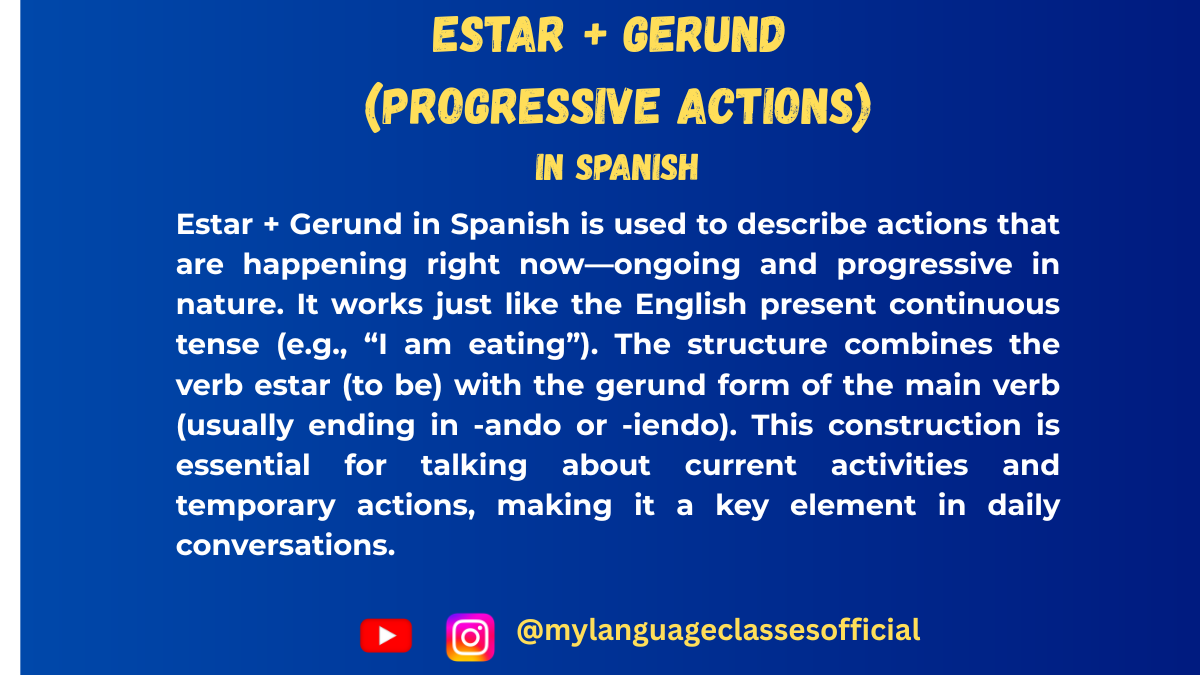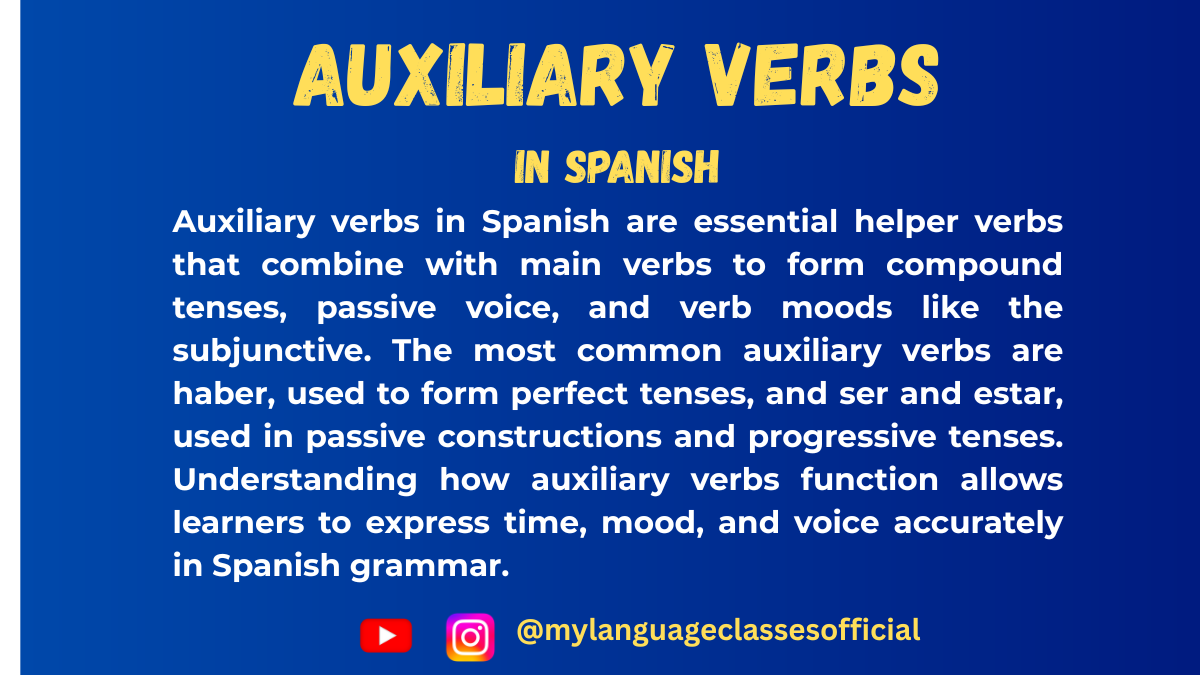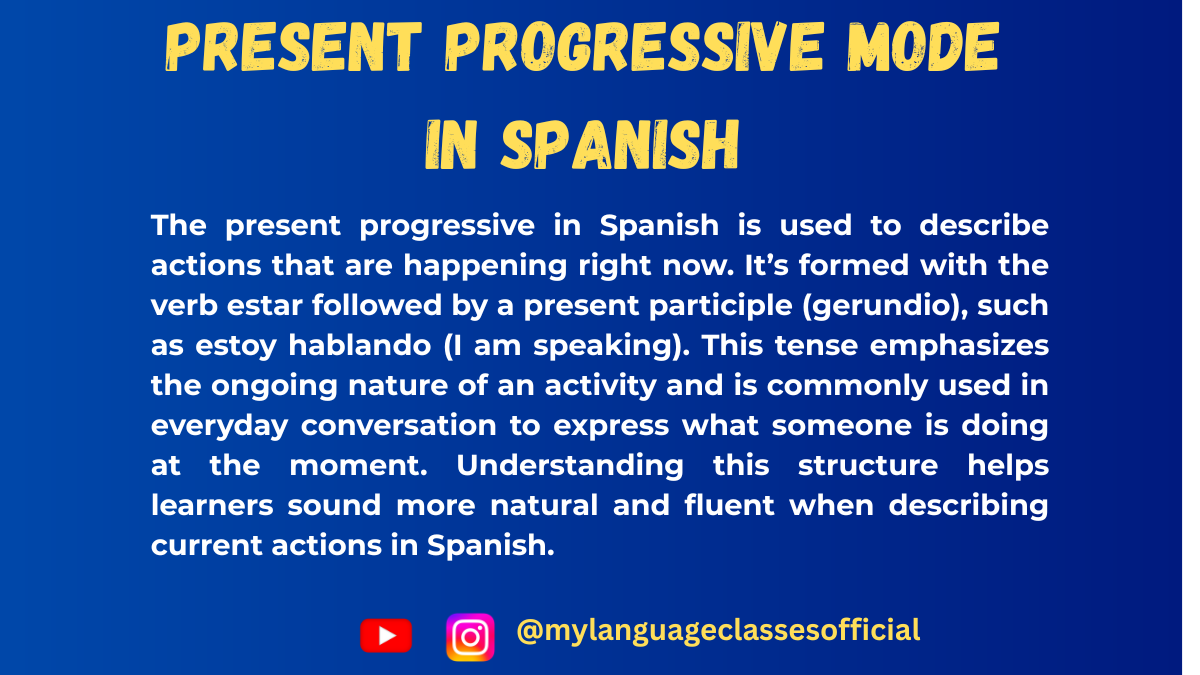Your cart is currently empty!
Tag: Spanish progressive tense
-

Estar + Gerund (Progressive Actions) in Spanish
In Spanish, the structure Estar + gerund is used to express actions that are in progress at the moment of speaking or during a specific time frame. This is equivalent to the English present continuous tense (e.g., “I am eating”) or past continuous tense (e.g., “I was eating”). The gerundio (gerund) is a verb form that ends in -ando (for -ar verbs) or -iendo (for -er and -ir verbs). Understanding how to use Estar + gerund is essential for describing ongoing actions in Spanish.
In this blog, we’ll explore common expressions, conjugation rules, irregular verbs, and examples to help you master this grammatical structure.
Common Expressions Using Estar + Gerund
Here’s a list of common expressions using Estar + gerundio that are frequently used in day-to-day Spanish conversations:
Expression Meaning Estoy hablando I am speaking Estás comiendo You are eating Está leyendo He/She is reading Estamos trabajando We are working Están corriendo They are running Estoy aprendiendo I am learning Estás durmiendo You are sleeping Está escribiendo He/She is writing Estamos viajando We are traveling Están bailando They are dancing
Things to Keep in Mind
When using Estar + gerund, keep the following points in mind:
- Articles and Gender: The gerund form does not change according to gender or number. It remains the same regardless of the subject.
- Example:
- Estoy hablando (I am speaking)
- Estamos hablando (We are speaking)
- Example:
- Reflexive Verbs: When using reflexive verbs, the reflexive pronoun (me, te, se, nos, os, se) can be placed before estar or attached to the gerund.
- Example:
- Me estoy lavando. (I am washing myself.)
- Estoy lavándome. (I am washing myself.)
- Example:
- Tense Agreement: Estar must agree with the subject in person and number. The gerund remains unchanged.
- Example:
- Estoy comiendo (I am eating)
- Están comiendo (They are eating)
- Example:
- Avoid Overuse: In Spanish, the simple present tense is often used to describe ongoing actions, especially in informal contexts. Use Estar + gerund when emphasizing the progression of an action.
When to Use Estar + Gerund
The structure Estar + gerundio is used in the following situations:
- Actions in Progress: To describe actions happening at the moment of speaking.
- Example: Estoy cocinando. (I am cooking.)
- Temporary Actions: To describe actions that are ongoing but not permanent.
- Example: Está estudiando para el examen. (He/She is studying for the exam.)
- Simultaneous Actions: To describe two actions happening at the same time.
- Example: Estoy hablando por teléfono mientras cocino. (I am talking on the phone while cooking.)
- Emphasizing Duration: To emphasize the duration of an action.
- Example: Estuvimos esperando por horas. (We were waiting for hours.)
Conjugation of Estar + Gerund
Regular Verbs
To form the gerund of regular verbs:
- -AR Verbs: Replace -ar with -ando.
- Example: Hablar → Hablando (speaking)
- -ER Verbs: Replace -er with -iendo.
- Example: Comer → Comiendo (eating)
- -IR Verbs: Replace -ir with -iendo.
- Example: Vivir → Viviendo (living)
Irregular Verbs
Some verbs have irregular gerund forms. Here are the most common ones:
- Ir (to go) → Yendo (going)
- Leer (to read) → Leyendo (reading)
- Oír (to hear) → Oyendo (hearing)
- Dormir (to sleep) → Durmiendo (sleeping)
- Morir (to die) → Muriendo (dying)
10 Regular and Irregular Verbs in Estar + Gerund
Verb Gerund Example Sentence Meaning Hablar Hablando Estoy hablando con mi amigo. I am talking to my friend. Comer Comiendo Está comiendo una manzana. He/She is eating an apple. Vivir Viviendo Estamos viviendo en Madrid. We are living in Madrid. Escribir Escribiendo Están escribiendo una carta. They are writing a letter. Leer Leyendo Estoy leyendo un libro interesante. I am reading an interesting book. Dormir Durmiendo Está durmiendo en su cama. He/She is sleeping in their bed. Ir Yendo Estamos yendo al parque. We are going to the park. Oír Oyendo Está oyendo música. He/She is listening to music. Correr Corriendo Están corriendo en el parque. They are running in the park. Bailar Bailando Estoy bailando en la fiesta. I am dancing at the party.
More Example Sentences

Estar + Gerund In Spanish Example sentences
- Estoy aprendiendo español. (I am learning Spanish.)
- Estás cocinando la cena. (You are cooking dinner.)
- Están jugando fútbol en el parque. (They are playing soccer in the park.)
- Está lloviendo mucho hoy. (It is raining a lot today.)
- Estamos esperando el autobús. (We are waiting for the bus.)
- Estoy trabajando desde casa. (I am working from home.)
- Está nevando en las montañas. (It is snowing in the mountains.)
- Están estudiando para el examen. (They are studying for the exam.)
- Estamos planeando un viaje. (We are planning a trip.)
- Estoy leyendo las noticias. (I am reading the news.) My Language Classes
Fill in the Blanks
- Estoy __________ (hablar) por teléfono.
- Ella está __________ (comer) una pizza.
- Nosotros estamos __________ (vivir) en México.
- Ellos están __________ (escribir) un ensayo.
- Estoy __________ (leer) un libro.
- Tú estás __________ (dormir) en el sofá.
- Estamos __________ (ir) al cine.
- Está __________ (oír) música clásica.
- Ellos están __________ (correr) en el parque.
- Estoy __________ (bailar) salsa.
Answers:
- hablando
- comiendo
- viviendo
- escribiendo
- leyendo
- durmiendo
- yendo
- oyendo
- corriendo
- bailando
Conclusion
Mastering Estar + gerund is a key step in becoming fluent in Spanish. This structure allows you to describe ongoing actions, emphasize duration, and express simultaneous activities. By practicing the conjugations, memorizing common expressions, and understanding the rules, you’ll be able to use this grammatical form confidently in your conversations. ¡Sigue practicando! (Keep practicing!)
Let me know if you need further clarification or additional examples! 😊
If you enjoyed this lesson, be sure to check out more posts like this on my blog at My Language Classes. Don’t forget to subscribe my YouTube channel and follow me on Instagram for the latest language learning tips and lessons. Leave a comment below to share your thoughts, or ask any questions you have about nouns.
Happy learning! 😊
- 100 Spanish Example Sentences
- 100 Spanish Fill-in-the-Blanks Exercises
- 100 Spanish Vocabulary Lists
- Spanish – Advanced
- Spanish – Beginner
- Spanish – Intermediate
- Articles and Gender: The gerund form does not change according to gender or number. It remains the same regardless of the subject.
-

Auxiliary Verbs in Spanish: A Complete Guide
Auxiliary verbs, or “verbos auxiliares” in Spanish, play a crucial role in forming various tenses, moods, and grammatical structures. They are used in conjunction with main verbs to express nuances such as obligation, ability, probability, or temporality. Understanding auxiliary verbs is essential for mastering Spanish fluency.
Common Auxiliary Verbs in Spanish
- Haber (to have – for perfect tenses)
- Ser (to be – for passive voice and descriptions)
- Estar (to be – for progressive tenses and states)
- Tener que (to have to – for obligations)
- Deber (must/should – for necessity and advice)
- Poder (can – for ability and permission)
- Ir a (going to – for future actions)
- Querer (to want – for desires and intentions)
- Soler (to usually – for habitual actions)
1. Haber: Forming Perfect Tenses
Haber is used as an auxiliary verb to form compound tenses like the present perfect, past perfect, and future perfect.
Conjugation of Haber (Present Indicative):
- Yo he
- Tú has
- Él/Ella/Usted ha
- Nosotros/as hemos
- Vosotros/as habéis
- Ellos/Ellas/Ustedes han
Example Sentences:
- Yo he comido hoy. (I have eaten today.)
- ¿Has visto la película? (Have you seen the movie?)
Things to Keep in Mind:
- The past participle always remains unchanged (e.g., comido, visto, escrito).
- Haber must be conjugated in the correct tense and subject agreement.
2. Ser and Estar: Expressing Passive Voice and Progressive Tenses
- Ser is used for the passive voice and permanent characteristics.
- Estar is used for the present progressive tense and temporary conditions.
Conjugation of Ser (Present Indicative):
- Yo soy
- Tú eres
- Él/Ella/Usted es
- Nosotros/as somos
- Vosotros/as sois
- Ellos/Ellas/Ustedes son
Conjugation of Estar (Present Indicative):
- Yo estoy
- Tú estás
- Él/Ella/Usted está
- Nosotros/as estamos
- Vosotros/as estáis
- Ellos/Ellas/Ustedes están
Example Sentences:
- La puerta es cerrada por el profesor. (The door is closed by the teacher.)
- Estoy estudiando español. (I am studying Spanish.)
3. Tener que, Deber, and Poder: Expressing Obligation, Necessity, and Ability
- Tener que + infinitive: Expresses strong obligation.
- Ejemplo: Tengo que trabajar mañana. (I have to work tomorrow.)
- Deber + infinitive: Expresses necessity or recommendation.
- Ejemplo: Debes hacer ejercicio. (You should exercise.)
- Poder + infinitive: Expresses ability or permission.
- Ejemplo: ¿Puedes ayudarme? (Can you help me?)
4. Ir a + Infinitive: Talking About the Near Future
This structure is similar to the English “going to.” It is commonly used in spoken Spanish.
Example Sentences:
- Voy a viajar a España. (I am going to travel to Spain.)
- ¿Vas a llamar a tu madre? (Are you going to call your mother?)
5. Querer and Soler: Expressing Intentions and Habits
- Querer + infinitive: Expresses desire.
- Ejemplo: Quiero aprender español. (I want to learn Spanish.)
- Soler + infinitive: Expresses habitual actions.
- Ejemplo: Suelo leer antes de dormir. (I usually read before sleeping.)
Conjugation of Regular and Irregular Verbs in Auxiliary Verb Constructions
Spanish verbs fall into three categories: -AR, -ER, and -IR verbs.
Regular Verb Conjugation in the Present Participle (Gerundio)
- -AR verbs: hablar → hablando (speaking)
- -ER verbs: comer → comiendo (eating)
- -IR verbs: vivir → viviendo (living)
Past Participle Formation (Used with Haber)
- -AR verbs: hablar → hablado
- -ER verbs: comer → comido
- -IR verbs: vivir → vivido
Irregular Past Participles
- Decir → dicho (said)
- Hacer → hecho (done)
- Ver → visto (seen)
- Escribir → escrito (written)
List of Common Expressions with Auxiliary Verbs
Here are some daily expressions using auxiliary verbs:
- ¿Has comido? (Have you eaten?)
- Voy a salir ahora. (I am going to leave now.)
- Puedes ayudarme, por favor. (Can you help me, please?)
- Debemos estudiar más. (We must study more.)
- Tienes que llamar a tu madre. (You have to call your mother.)
Things to Keep in Mind
- Gender and Plurality: Auxiliary verbs themselves do not change for gender, but past participles used with “ser” must agree in gender and number (e.g., “La tarea fue hecha.”)
- Use of Articles: In general, articles (el, la, los, las) are necessary with nouns but not with infinitive verbs.
- Reflexive Verbs: When using auxiliary verbs with reflexive verbs, place the reflexive pronoun before the auxiliary verb or attach it to the infinitive (e.g., “Me voy a duchar” / “Voy a ducharme”).
Final Thoughts
Mastering auxiliary verbs in Spanish is essential for building more complex sentences and improving fluency. Understanding when and how to use “haber,” “ser,” “estar,” “tener que,” and other auxiliary verbs will help you navigate Spanish conversations with ease. Keep practicing with real-life examples, and soon, using these verbs will become second nature!
¿Quieres seguir aprendiendo? (Do you want to keep learning?) Stay tuned for more Spanish lessons!
If you enjoyed this lesson, be sure to check out more posts like this on my blog at My Language Classes. Don’t forget to subscribe my YouTube channel and follow me on Instagram for the latest language learning tips and lessons. Leave a comment below to share your thoughts, or ask any questions you have.
Happy learning! 😊
-

Mastering Present Progressive in Spanish
The present progressive tense (or continuous tense) is one of the most practical and dynamic structures in Spanish. It’s the equivalent of the English “present continuous” tense and is used to describe actions happening right now. If you’ve ever said something like “I am studying” in English, you’ve used a structure similar to Spanish: “Estoy estudiando.”
In this guide, you’ll learn what the present progressive is, how to form it correctly, when to use it, common irregularities, and common mistakes to avoid. Let’s dive in!
What is the Present Progressive?
The present progressive is used to describe actions that are happening right now. It combines the verb estar (to be) as an auxiliary with another verb in its gerund form.
For example:
- Estoy escribiendo (I am writing).
- Estamos aprendiendo español (We are learning Spanish).
How to Form the Present Progressive
1. Conjugate the Verb “Estar”
First, conjugate estar in the present tense according to the subject. Here’s a quick review:
Subject Conjugation of “Estar” Yo estoy Tú estás Él/Ella/Usted está Nosotros/as estamos Vosotros/as estáis Ellos/Ellas/Ustedes están 2. Add the Gerund Form of the Main Verb
The gerund (or present participle) is formed by adding -ando to the stem of -ar verbs and -iendo to the stem of -er and -ir verbs.
Verb Type Example Verb Gerund Form Example -AR Hablar Hablando Estoy hablando (I am speaking). -ER Comer Comiendo Estás comiendo (You are eating). -IR Vivir Viviendo Ellos están viviendo (They are living).
Irregularities in Present Progressive Formation
While most verbs follow the standard -ando/-iendo pattern, some verbs have irregular gerund forms. These can be categorized based on their unique characteristics:
1. Verbs with Spelling Changes
Some verbs change spelling in the gerund to maintain proper pronunciation or avoid awkward letter combinations.
Verb Gerund Form Example Leer Leyendo Estoy leyendo (I am reading). Construir Construyendo Están construyendo (They are building). Oír Oyendo Está oyendo (He/She is hearing). Caer Cayendo Estoy cayendo (I am falling).
2. Stem-Changing Verbs in -IR
Stem-changing verbs that end in -ir modify their stem vowel in the gerund form. These changes occur in verbs that have e → i or o → u shifts in the present tense.
Verb Gerund Form Example Dormir Durmiendo Estoy durmiendo (I am sleeping). Morir Muriendo Está muriendo (He/She is dying). Servir Sirviendo Están sirviendo (They are serving). Pedir Pidiendo Estoy pidiendo (I am requesting).
3. Irregular Verbs with Unique Forms
Certain highly irregular verbs have gerunds that do not follow standard rules.
Verb Gerund Form Example Ir Yendo Estoy yendo (I am going). Poder Pudiendo Está pudiendo (He/She is able to). Venir Viniendo Estamos viniendo (We are coming).
When to Use the Present Progressive
Use the present progressive when describing actions that are happening right now or in the immediate present. Examples include:
- ¿Qué estás haciendo? (What are you doing?)
- Estoy estudiando para un examen. (I am studying for a test.)
- Estamos trabajando en un proyecto. (We are working on a project.)
Common Mistakes to Avoid
- Overusing the Present Progressive In Spanish, the simple present tense is often used instead of the present progressive for habitual actions or near-future events. For example:
- English: I am going to the store tomorrow.
- Correct Spanish: Voy a la tienda mañana. (Not Estoy yendo a la tienda mañana.)
- Incorrect Gerund Formation Remember the spelling and stem changes discussed above. For example:
- Incorrect: Están leiendo.
- Correct: Están leyendo.
- Forgetting to Conjugate “Estar” Always ensure that estar matches the subject of the sentence. For example:
- Incorrect: Ellos está comiendo.
- Correct: Ellos están comiendo.
Practice Exercises
Try these sentences and check your understanding:
- I am listening to music. → (Translate to Spanish)
- We are running in the park. → (Translate to Spanish)
- What are you writing? → (Translate to Spanish)
Conclusion
The present progressive is an essential tool for Spanish learners, especially when you want to describe ongoing actions. By mastering estar + gerundio and learning how to handle irregular verbs, you’ll speak Spanish with greater fluency and confidence. Practice regularly, and don’t be afraid to make mistakes—they are part of the learning process!
¿Qué estás esperando? (What are you waiting for?) Start using the present progressive in your Spanish conversations today!
